The Quran and Cosmology
 T the time the Holy Quran was revealed, the human understanding of the nature of the cosmos and the movement or the stillness of the heavenly bodies was extremely primitive and obscure. This is no longer the case, as our knowledge of the universe has considerably advanced and expanded by the present age.
T the time the Holy Quran was revealed, the human understanding of the nature of the cosmos and the movement or the stillness of the heavenly bodies was extremely primitive and obscure. This is no longer the case, as our knowledge of the universe has considerably advanced and expanded by the present age.
Some of the theories relating to the creation of the universe have been verified as facts, whereas some others are still being explored. The concept of the expanding universe belongs to the former category, and has been universally accepted by the scientific community as 'fact'. This discovery was first made by Edwin Hubble in the 1920s. Yet some thirteen centuries before this, it was clearly mentioned in the Quran:
And the heaven We built with Our own powers (aydin) and indeed We go on expanding it (musi'un).1
It should be remembered that the concept of the continuous expansion of the universe is exclusive to the Quran. No other Divine scriptures even remotely hint at it. The discovery that the universe is constantly expanding is of prime significance to scientists, because it helps create a better understanding of how the universe was initially created. It clearly explains the stage by stage process of creation, in a manner which perfectly falls into step with the theory of the Big Bang. The Quran goes further and describes the entire cycle of the beginning, the end and the return again to a similar beginning. The first step of creation as related in the Quran accurately describes the event of the Big Bang in the following words:
Do not the unbelievers see that the heavens and the earth were a closed-up mass (ratqan), then We clove them asunder (fataqna)? And We made from water every living thing. Will they not then believe?2
It is significant that this verse is specifically addressed to non-believers, implying perhaps, that the unveiling of the secret mentioned in this verse would be made by the non-believers, a sign for them of the truth of the Quran.
In this verse the words ratqan (closed-up mass), and fataqna (We clove them asunder), carry the basic message of the whole verse. Authentic Arabic lexicons3 give two meanings of ratqan, that have great relevance to the topic under discussion. One meaning is 'the coming together of something and the consequent infusion into a single entity' and the second meaning is 'total darkness'. Both these meanings are significantly applicable. Taken together, they offer an apt description of the singularity of a black hole.
 BLACK HOLE is a gravitationally collapsed mass of colossal size. It begins with the collapse of such massive stars as are 15 or more times the size of the sun. The immensity of their inward gravitational pull causes the stars to collapse into a much smaller size. The gravitational pull is further concentrated and results in the further collapse of the entire mass into a supernova. At this stage the basic bricks of matter such as molecules, atoms etc. begin to be crushed into a nondescript mass of energy. Thus that moment in space-time is created which is called event horizon. The inward gravitational pull of that something becomes so powerful that all forms of radiation are pulled back so that even light cannot escape. A resultant total darkness ensues which earns it the name black hole, reminding one of the word ratqan used by the Quran indicating total darkness. This is called singularity which lies beyond the event horizon.
BLACK HOLE is a gravitationally collapsed mass of colossal size. It begins with the collapse of such massive stars as are 15 or more times the size of the sun. The immensity of their inward gravitational pull causes the stars to collapse into a much smaller size. The gravitational pull is further concentrated and results in the further collapse of the entire mass into a supernova. At this stage the basic bricks of matter such as molecules, atoms etc. begin to be crushed into a nondescript mass of energy. Thus that moment in space-time is created which is called event horizon. The inward gravitational pull of that something becomes so powerful that all forms of radiation are pulled back so that even light cannot escape. A resultant total darkness ensues which earns it the name black hole, reminding one of the word ratqan used by the Quran indicating total darkness. This is called singularity which lies beyond the event horizon.
A black hole once created grows rapidly because even distant stars begin to be pulled in with the progressive concentration of gravitational energy. It is estimated that the mass of a black hole could grow as large as a hundred million times the mass of the sun. As its gravitational field widens, more material from space is drawn in at a speed close to that of light. In 1997 there was observational evidence suggesting that in our galaxy a black hole of 2,000,000 solar masses existed. But other calculations show that in our universe there could be many black holes as big as 3,000,000,000 solar masses.4 At that concentration of gravitational pull even distant stars would stagger and lose their mooring to be devoured by a glutton of such magnitude. Thus the process of ratqan is completed resulting into that singularity which is both completely closed as well as comprising total darkness. In answer to the question as to how the universe was initially created, the two most recent theories are both Big Bang theories. They claim that it was initiated from a singularity which suddenly erupted releasing the trapped mass leading yet again into the creation of a new universe through the event horizon. This dawn of light sprouting from the event horizon is called the white hole5,6. One of the two theories relating to the expansion predicts that the universe thus created will carry on expanding forever. The other claims that the expansion of the universe will, at some time, be reversed because the inward gravitational pull will ultimately prevail. Eventually, all matter will be pulled back again to form perhaps another gigantic black hole. This latter view appears to be supported by the Quran.
Whilst speaking of the first creation of the universe, the Quran clearly describes its ending into yet another black hole, connecting the end to the beginning, thus completing the full circle of the story of cosmos. The Quran declares:
Remember the day when We shall roll up the heavens like the rolling up of written scrolls ...7
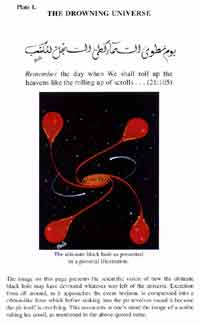 |
Plate 1: The Ultimate Black Hole
(click to enlarge) |
The clear message of this verse is that the universe is not eternal. It speaks of a future when the heavens will be rolled up, in a manner similar to the rolling up of a scroll. Scientific descriptions illustrating the making of a black hole, very closely resemble what the Quran describes in the above verse. (See plate 1).
A mass of accretion from space falling into a black hole, as described above, would be pressed into a sheet under the enormous pressure created by the gravitational and electromagnetic forces. As the centre of the black hole is constantly revolving around itself, this sheet—as it approaches—will begin to be wrapped around it, before disappearing into the realm of the unknown at last.
The verse continues:
... As We began the first creation, so shall We repeat it; a promise binding on Us; that We shall certainly fulfil.7
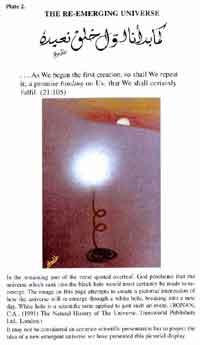 |
Plate 2: The Emergent Universe
(click to enlarge) |
Following the eventual collapse of the universe into a black hole, here we have the promise of a new beginning. God will recreate the universe, as He had done before. The collapsed universe will re-emerge from its darkness and the whole process of creation will start yet again (see plate 2). This wrapping up and unfolding of the universe appears to be an ongoing phenomenon, according to the Holy Quran.
This Quranic concept of the beginning and the end of the creation is undoubtedly extraordinary. It would not have been less amazing if it had been revealed to a highly educated person of our contemporary age, but one is wonder-struck by the fact that this most advanced knowledge, regarding the perpetually repeating phenomenon of creation, was revealed more than fourteen hundred years ago to an unlettered dweller of the Arabian desert.
 he Quran and the Heavenly Bodies
he Quran and the Heavenly Bodies
Now we turn to another aspect of the description of the cosmos which relates to the motion of the heavenly bodies. The most striking feature of this description relates to the way the motion of the earth is described without glaringly contradicting the popular view prevailing in that age. All the scholars and sages of that time were unanimous in their belief that the earth is stationary while other heavenly bodies like the sun and the moon are constantly revolving around it. In view of this, the motion of the earth as described by the Quran may not be apparent to the casual reader, but to a careful student the message is loud and clear. If the Quran had described the earth as stationary and the heavenly bodies as revolving around it, then although the people of that time might have been satisfied with this description, the people of the later ages would have treated that statement as a proof of the ignorance of the Quran's author. Such a statement, they would emphasize, could not have been made by an All-Knowing, Supreme Being.
Rather than literally comparing the motion of the earth to that of other heavenly bodies, the Quran makes the following statement:
The mountains that you see, you think they are stationary while they are constantly floating like the floating of clouds. Such is the work of Allah Who made everything firm and strong...8
If the mountains are declared to be in constant motion, then the only logical inference to be drawn from this would be that the earth is also rotating along with them. But thanks to the masterly language of the Quran this observation went unnoticed. They had the impression, shared with the rest of mankind, that the earth was stationary and it was this false impression that was not obtrusively challenged. If they had read with care the end of the same verse they would have been left with no room for any misunderstanding. It ends with a lasting tribute to the creative faculty of God, Who has created all things with such firmness that they cannot be dislodged. Anything which cannot be dislodged can never be catapulted out of the earth, to fly alone, leaving the earth behind.
Again, in many other verses the Quran refers to the mountains as ravasiya which means 'firmly rooted in the earth':
He has created the heavens without any pillars that you can see, and He has placed in the earth firm mountains that it may not quake with you, and He has scattered therein all kinds of creatures; and We have sent down water from the clouds, and caused to grow therein every noble species.9
Also:
And We have made in the earth firm mountains, that they may provide them the living food, and We have made therein wide pathways that they may be rightly guided.10
and,
And He has placed in the earth firm mountains that they may provide you food, and rivers and routes that you may be guided.11
Thus, the Holy Quran exquisitely succeeds in making this revelation in a manner that the prevalent knowledge of that time is not too loudly challenged. It is likely that the people may have believed verse 89 of Surah Al-Naml, referred to a future event associated with Doomsday. But as has been demonstrated, this misinterpretation would be absolutely unacceptable for the following reasons:
- The verse clearly speaks in the present tense and not in the future tense. The letter (
 ) vaow used here can literally be translated as 'while' instead of 'and', so the meaning could be, 'you think the mountains are stationary, while they are moving'. To refer this part of the statement to the future is impermissible.
) vaow used here can literally be translated as 'while' instead of 'and', so the meaning could be, 'you think the mountains are stationary, while they are moving'. To refer this part of the statement to the future is impermissible. - If they, the mountains, were to fly in the future then how could man, even if he were perched at a safe distance on another planet, believe them to be stationary despite watching them flying in space? Hence such a translation is out of the question. Also, to translate this verse to indicate that though humans today consider the mountains to be stationary, they are not so because in future they will fly, would be evidently wrong. If the mountains are stationary today the humans would certainly see them to be stationary. It is not a question of their thinking them to be stationary. The Quran would have said 'You know them to be stationary and so they are but in future they will no longer be so'. This is not what the Quran says at all.
- At the end of the same verse, a tribute to the firmness of God's creation is the last clinching proof that the mountains, despite flying, are firmly entrenched.
It is noteworthy that the early commentaries maintain silence on the true meaning of this verse which suggests that it was too difficult for them to interpret.
The Holy Quran also pronounces that all heavenly bodies are in a constant state of motion; none of them is stationary:
... everything is gliding along smoothly in its orbit.12
This all-embracing statement covers the entire universe, our solar system being no exception. In addition to this, there are many other verses which mention the elliptical movement of all the heavenly bodies. But they also speak of their movement towards their destined time of death. Following are some of the verses which cover both subjects:
Allah is He Who raised up the heavens without any pillars that you can see. Then He settled Himself on the Throne. And He pressed the sun and the moon into service. All pursue their course until an appointed time. He regulates it all. He clearly explains the Signs, that you may have a firm belief in the meeting with your Lord.13
Hast thou not seen that Allah makes the night pass into the day, and makes the day pass into the night, and He has pressed the sun and the moon into service; all pursuing their course till an appointed term, and Allah is well aware of what you do?14
He merges the night into the day, and He merges the day into the night. And He has pressed into service the sun and the moon; each one runs its course to an appointed term. Such is Allah, your Lord; His is the kingdom, and those whom you call upon beside Allah own not even a whit.15
He created the heavens and earth in accordance with the requirements of wisdom. He makes the night to cover the day, and He makes the day to cover the night; and He has pressed the sun and the moon into service; each pursues its course until an appointed time. Hearken, it is He alone Who is the Mighty, the Great Forgiver.16
 OW we turn to another amazing revelation of the Quran regarding a specific motion of the sun which is mentioned nowhere else. This verse 36:39, pronounces,
OW we turn to another amazing revelation of the Quran regarding a specific motion of the sun which is mentioned nowhere else. This verse 36:39, pronounces,
And the sun is constantly moving in the direction of its ultimate abode of rest. This is the decree of the Almighty, the All-Knowing.17
It clearly speaks of a point in space to be the sun's final resting place. Despite the fact that it is only the sun which is mentioned, the verses which immediately follow bind the entire universe to the movement of the sun in the same specific direction:
And the sun is constantly moving in the direction of its ultimate abode of rest. This is the decree of the Almighty, the All-Knowing.
And for the moon We have regulated stages until it looks like a thin branch of an old palm tree.
Nor does it behove for the sun to overtake the moon nor for the night to overtake the day ...18
If it were only the sun which was moving in a fixed direction, the verse which follows this statement would not have proclaimed that the sun and the moon strictly maintain their mutual distance; they will never be able to gain or move away from each other, an unchangeable destiny till their appointed time. This clearly shows that in whatever direction the sun is moving, the moon is also moving.
But it is not only the question of the sun and the moon. All the heavenly bodies are described in the Quran as soundlessly floating. Again there are numerous verses in the Quran which describe the heavenly bodies bound together with invisible links. Hence if one of them moves in a direction other than its orbital and elliptical motion, all the other heavenly bodies must also move along to maintain their mutual balance.
And He it is Who created the night and the day, and the sun and the moon; everything gliding along in orbit.19
It is not for the sun to overtake the moon, nor can the night outstrip the day. All float in an orbit.20
This is a unique style of the Quran also employed for indicating the movement of the earth upon its axis. The people of the time of both these revelations could not clearly grasp the underlying idea. If the mountains are moving the earth must also move along, but this is not what the people of that age inferred. Nor could they grasp the idea that if the sun is moving in the direction of a specific space, the entire universe must also be moving along with it to the same destination. This vision of the entire universe drifting away in space is an idea which perhaps has not as yet been conceived by contemporary scientists. Yet it can be implied from an in-depth study of the Quran that the entire cosmos is moving towards some point in space. If that implication is true then one is left with no choice but to visualize all 180 billion or more galaxies, of which our planetary system is but a tiny dot, to be moving along with the sun in a set direction.
 LSEWHERE IN THE CHAPTER we have suggested the possibility of an all-consuming gigantic black hole which may pull back the entire universal mass into its singularity.
LSEWHERE IN THE CHAPTER we have suggested the possibility of an all-consuming gigantic black hole which may pull back the entire universal mass into its singularity.
As such, we have concluded that according to the Quran the case of the universe is an open and shut case. At the moment of the Big Bang it began to expand almost at the speed of light. At the end it will once again be drawn back into the abyss which we refer to as a black hole.
As far as the concept of a single universal black hole is concerned, it is based on the Big Bang theory which is fully supported by the Quran. Some scientists however, propose the case of an open universe. They believe that the universe will continue to expand forever and ever until the spacial matter becomes too thin and sparse, and extends beyond the gravitational pull of the centre of the universe. This scenario leaves no room for the universe to be reassembled and recreated. The Quran categorically rejects this open concept. It is loud, clear and specific that from a singularity the universe erupted, and back into another singularity it will sink again. The Unity of God and its creative outburst and the return of the creation again to the Unity of God could not have been better expressed than:
... to God we belong and to Him shall we return.21
REFERENCES
- Translation of 51:48 by the author.
- Translation of 21:31 by the author.
- LANE, E.W. (1984) Arabic—English Lexicon. Islamic Text Society, William & Norgate, Cambridge.
- Space Telescope Science Institute. (1997) Press release no. STScI-PR97-01, Baltimore, Maryland, USA.
- RONAN, C. A. (1991) The Natural History of the Universe. Transworld Publishers Ltd., London.
- Reader's Digest Universal Dictionary. (1987) The Reader's Digest Association Limited. London.
- Translation of 21:105 by the author.
- Translation of 27:89 by the author.
- Translation of 31:11 by Maulawi Sher Ali.
- Translation of 21:32 by the author.
- Translation of 16:16 by the author.
- Translation of 21:34 by the author.
- Translation of 13:3 by the author.
- Translation of 31:30 by Maulawi Sher Ali.
- Translation of 35:14 by Maulawi Sher Ali.
- Translation of 39:6 by Maulawi Sher Ali.
- Translation of 36:39 by the author.
- Translation of 36:39–41 by the author.
- Translation of 21:34 by the author.
- Translation of 36:41 by the author.
- Translation of 2:157 by the author.
![]() We created man from an extract of clay. Then We made him as a drop in a place of settlement, firmly fixed. Then We made the drop into an alaqah (leech, suspended thing, and blood clot), then We made the alaqah into a mudghah (chewed substance)...
We created man from an extract of clay. Then We made him as a drop in a place of settlement, firmly fixed. Then We made the drop into an alaqah (leech, suspended thing, and blood clot), then We made the alaqah into a mudghah (chewed substance)... ![]() 1 (Quran, 23:12-14)
1 (Quran, 23:12-14)![]() have possibly known all this 1400 years ago, when scientists have only recently discovered this using advanced equipment and powerful microscopes which did not exist at that time? Hamm and Leeuwenhoek were the first scientists to observe human sperm cells (spermatozoa) using an improved microscope in 1677 (more than 1000 years after Muhammad
have possibly known all this 1400 years ago, when scientists have only recently discovered this using advanced equipment and powerful microscopes which did not exist at that time? Hamm and Leeuwenhoek were the first scientists to observe human sperm cells (spermatozoa) using an improved microscope in 1677 (more than 1000 years after Muhammad ![]() ). They mistakenly thought that the sperm cell contained a miniature preformed human being that grew when it was deposited in the female genital tract.7
). They mistakenly thought that the sperm cell contained a miniature preformed human being that grew when it was deposited in the female genital tract.7![]() ).
).![]() said, did, or approved of). The proposed system is simple, comprehensive, and conforms with present embryological knowledge. The intensive studies of the Quran and hadeeth (reliably transmitted reports by the Prophet Muhammad’s
said, did, or approved of). The proposed system is simple, comprehensive, and conforms with present embryological knowledge. The intensive studies of the Quran and hadeeth (reliably transmitted reports by the Prophet Muhammad’s ![]() companions of what he said, did, or approved of) in the last four years have revealed a system for classifying human embryos that is amazing since it was recorded in the seventh century A.D. Although Aristotle, the founder of the science of embryology, realized that chick embryos developed in stages from his studies of hen’s eggs in the fourth century B.C., he did not give any details about these stages. As far as it is known from the history of embryology, little was known about the staging and classification of human embryos until the twentieth century. For this reason, the descriptions of the human embryo in the Quran cannot be based on scientific knowledge in the seventh century. The only reasonable conclusion is: these descriptions were revealed to Muhammad from God. He could not have known such details because he was an illiterate man with absolutely no scientific training.”11 (View the RealPlayer video of this comment
companions of what he said, did, or approved of) in the last four years have revealed a system for classifying human embryos that is amazing since it was recorded in the seventh century A.D. Although Aristotle, the founder of the science of embryology, realized that chick embryos developed in stages from his studies of hen’s eggs in the fourth century B.C., he did not give any details about these stages. As far as it is known from the history of embryology, little was known about the staging and classification of human embryos until the twentieth century. For this reason, the descriptions of the human embryo in the Quran cannot be based on scientific knowledge in the seventh century. The only reasonable conclusion is: these descriptions were revealed to Muhammad from God. He could not have known such details because he was an illiterate man with absolutely no scientific training.”11 (View the RealPlayer video of this comment ![]() ).
).![]() ...
... ![]() in this web site is only a translation of the meaning of the Quran. It is not the Quran itself, which is in Arabic.
in this web site is only a translation of the meaning of the Quran. It is not the Quran itself, which is in Arabic. ![]()
![]()
![]()
![]()
![]()
![]()
![]()
![]()
![]()
![]()
![]()
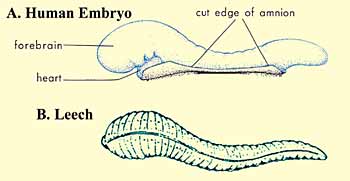
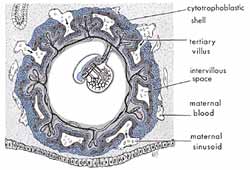
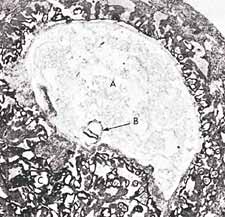
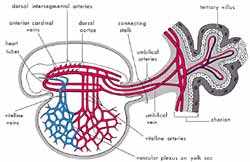
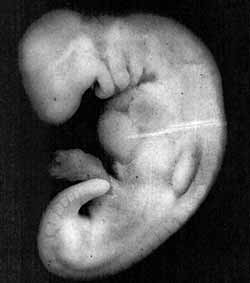
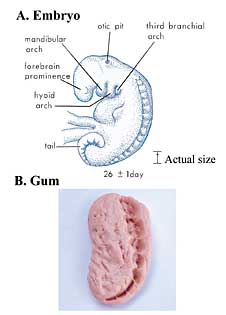














.jpeg)
